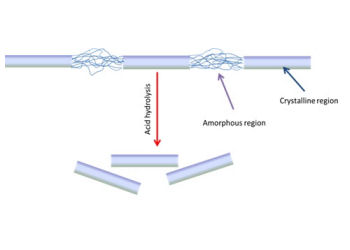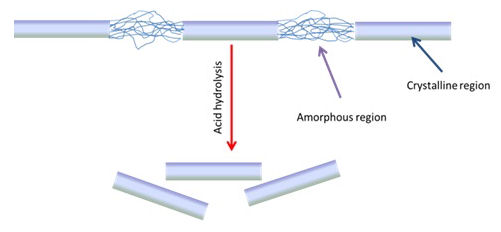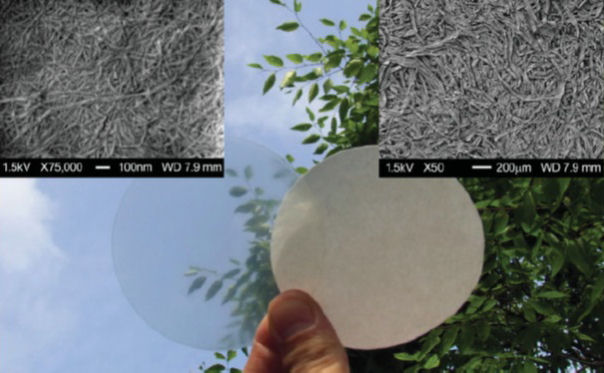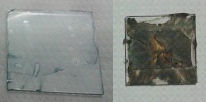 An optically transparent paper is appealing for a series of applications and can be attained by processing cellulose nanocrystals by standard paper-making procedures. The nano-dimensioned cellulose crystals produce a thin film with suppression of light scattering, thanks to the reduced dimension of interstices among nanofibers.
An optically transparent paper is appealing for a series of applications and can be attained by processing cellulose nanocrystals by standard paper-making procedures. The nano-dimensioned cellulose crystals produce a thin film with suppression of light scattering, thanks to the reduced dimension of interstices among nanofibers.
The nanofibers can be obtained by a top-down approach from various sources, including wood pulp. After removal of lignin and hemicellulose, the wood pulp can be processed by mechanic treatment or acid digestion. The process has the effect of removing the amorphous cellulose region, yielding nanocrystals with regular dimensions. The cartoon reported in Figure 1 represents how the process of acid hydrolysis can remove the amorphous cellulose and yield crystalline cellulose nanorods. The dimension, molecular weight and other properties of cellulose nanofibers are directly dependent on the nature of the pristine cellulose source (i.e. wood pulp, cotton, flax, hemp etc.).
Fig. 1: Acid hydrolysis of cellulose.
Cellulose nanocrystals with 150 nm length were used by M. Nogi et al.1 to prepare transparent nanopaper. The nanofibers were isolated from wood flour previously subjected to removal of lignin and hemicellulose. A preparation procedure adapted from the paper industry, including mechanical compression under vacuum at a pressure of 160 MPa, was used to produce high-quality nanopaper with limited water and voids content. A surface polishing process was also carried out to improve the transparency and aesthetic of the nanopaper. A powerful comparison of the nanopaper with a piece of filter paper is shown in Figure 2. Noteworthy, the scanning electron microscopy micrographs of the two samples show likewise morphologies with the main difference in the scale-bar: while appreciation of a normal paper sheet morphology is possible with a 50X magnification, revealing the presence of interwoven fibers with average length of 30 μm, the nanopaper demands for a higher magnification, down to the nanometer scale, to appreciate the presence of tinier nanorods that reveal reciprocal interconnection by their long dimension. The standard paper usually presents voids that must be leveled with fillers or adhesives. Nanopaper presents much more film-like surface morphology, with a very smooth and defect-free surface.
Fig. 2: Nanopaper (left) and paper (right) comparison. Optically transparent paper (left) is composed by 150 nm cellulose nanofibers. The upper left inset, with a scale bar of 100 nm, shows a SEM micrograph of the surface of transparent nanopaper. Conventional cellulose paper (right) is composed by 30 μm pulp fibers. The upper right inset, with a scale bar of 200 μm, shows the SEM micrograph of the surface of a sample of filter paper. Reproduced from Advanced Materials, Ref. 1, with permission from John Wiley and Sons.
With such a nice smooth surface morphology, deposition of organic material on top of nanopaper is possible. The limited presence of voids gives a valuable opportunity to deposit high quality organic thin films and opens the way to the fabrication of organic devices deposited on transparent nanopaper. Figure 3 shows thin films of organic conductive polymers deposited on nanopaper, as performed by spin coating in our laboratories at the Chemistry Department of the University of Bari.
Fig. 3: PEDOT:PSS (left) and a polythiophene-based organic polymer (right) spin cast on nanopaper (supported on a glass slide)
References: 1 M. Nogi, S. Iwamoto, A. N. Nakagaito, H. Yano, “Optically Transparent Nanofiber Paper” Adv. Mater. 2009, 21, 1595–1598, DOI: 10.1002/adma.200803174
THIS ARTICLE IS PART OF AN ACTION OF DISSEMINATION OF KNOWLEDGE AND RESULTS OF THE PROJECT SOLARLEAF, CO-FOUNDED BY COHESION AND DEVELOPMENT FUND 2007-2013 – APQ RESEARCH PUGLIA REGION “REGIONAL PROGRAMME SUPPORTING SMART SPECIALIZATION AND SOCIAL AND ENVIRONMENTAL SUSTAINABILITY – FUTUREINRESEARCH”, PROT. F6YRAO1.

Copyrights of this article belong to Alessandra Operamolla. All rights reserved.
